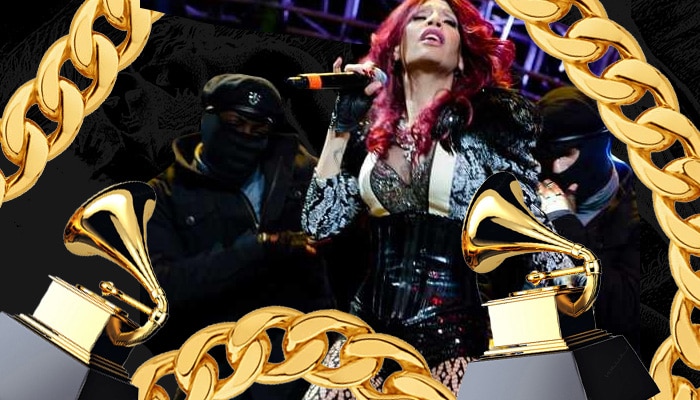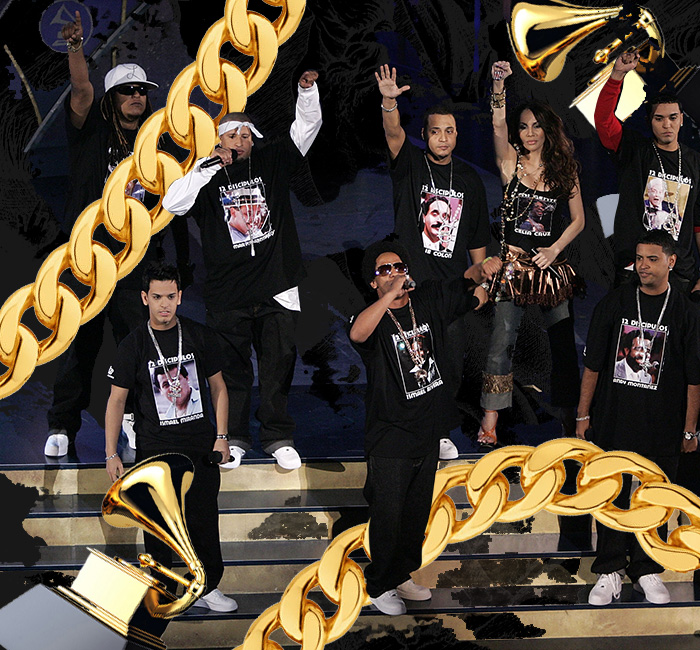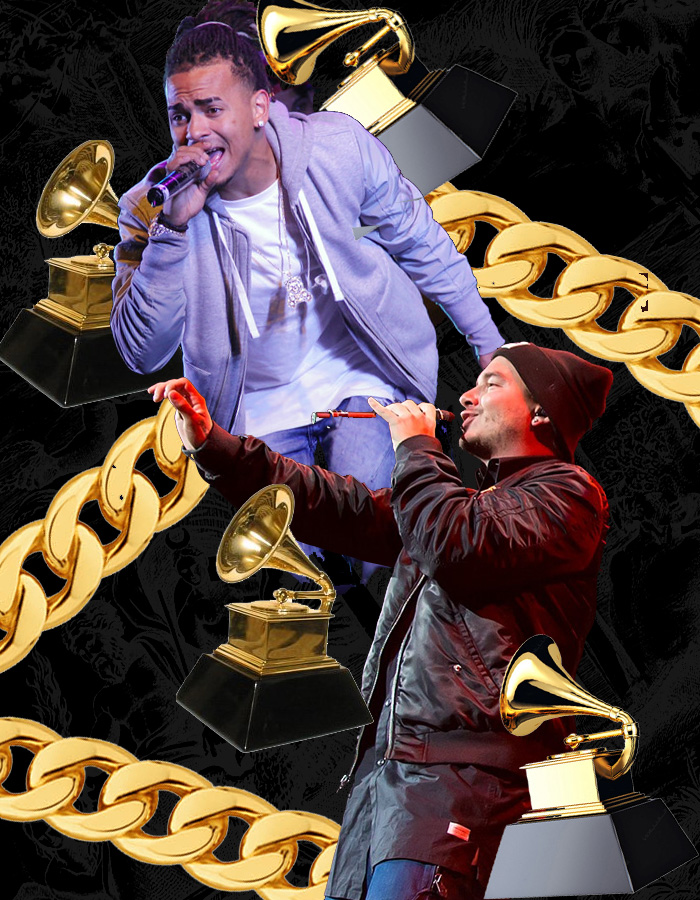Reggaeton began organically as a transformation of dancehall, hip-hop, and reggae en español. As an afro-diasporic movement, Panama, Puerto Rico, Jamaica, the Dominican Republic, and New York are all pivotal landscapes in the style’s musical evolution. Through Tu Pum Pum: The Story of Reggaeton, a column by Eduardo Cepeda, we’ll explore reggaeton’s history, sociopolitical struggles, and its impact as a global force in music and culture.
A palpable cultural shift swept over the 6th annual Latin Grammys in 2005 – the awards show finally welcomed many of reggaeton’s most emblematic performers. A genre that once fought for its right to exist now held a major place in the celebration billed as the biggest night in Latin music. Reggaeton’s groundswell was undeniable as Los 12 Discipulos ascended to the stage one by one for the now-iconic performance of “Quitate Tu Pa Ponerme Yo.” And their message was clear: Get out of our way. It’s our time.
Reggaeton’s first explosion brought sweeping change to the Spanish-language music industry. The mega stars of the early-aughts perreo era – Daddy Yankee, Ivy Queen, Tego Calderón, Don Omar, and many others – swarmed radio airwaves and the charts with a sense of authenticity that didn’t sacrifice their artistic integrity. Reggaeton was homegrown music that connected with young audiences, and it showed. It represented a shift away from the “crossover” era that saw artists like Ricky Martin play to Anglo audiences’ fascination with the “spicy Latin lover” trope (though arguably, it also introduced new stereotypes about Latinidad). Massive record sales and radio stations across the country (like South Florida’s La Mega 94.9 or Los Angeles’ KXOL Latino 96.3) flipped formats to focus on reggaeton, proving that Latinx youth were ready for a genre that better mirrored the communities they grew up in. But despite the industry’s commercial success from the sudden influx of eager audiences, many gatekeepers and consumers alike felt uncomfortable acknowledging reggaeton’s massive come up. Even today, many still do.
But even their primetime inclusion as performers couldn’t mask reggaeton’s dismissive relegation to the urbano category at the Grammys (outside of “Gasolina’s” Record of the Year nomination, which it lost). Many at the time saw reggaeton as nothing more than a hybrid of hip-hop and rap en español, and didn’t consider the genre to be authentically Latin American. By keeping reggaeton mostly in the urbano category – separate from the entertainers who were viewed as “authentic” – the Recording Academy reinforced those beliefs. As Kelefa Sanneh wrote in The New York Times ahead of the 2005 ceremony, “this hostility to reggaetón should be no surprise…to some voters, celebrating reggaetón might somehow seem like a betrayal of the ceremony’s emphasis on regional Latin styles.” It’s ironic that one of the bands who championed this kind of thinking, Mexican band Molotov, did so while performing rock music.
Reggaeton’s impact once again became visible to almost everyone – except the very music industry that benefited from its success.
Artists like Juanes, Alejandro Sanz, and Bebe dominated that night. With their accessible, pop-oriented sound, and their notably white(r) appearance, this was whom the Academy chose to celebrate. It’s worth noting that while Bebe won the Best New Artist award, her recent release at the time, Pafuera Telarañas, sold about 100,000 units in the U.S., while Daddy Yankee’s Barrio Fino sold about 1 million. And yes, it wasn’t about numbers, but rather about impact. Yet if that was truly the case, Barrio Fino – which boasted singles like “Gasolina,” that charted in over 15 countries, or “Lo Que Paso Paso,” which reached no. 2 on U.S. Hot Latin charts – has an impact that is is still present today. Yet he wasn’t even so much as nominated.
In the same New York Times article, Sanneh predicted that “by the time reggaetón stars start winning Latin Grammys by the armload, they won’t need them.” This was a painfully accurate analysis of reggaeton’s power, but an embarrassingly (for the industry) inaccurate prediction about reggaeton’s future. Surely no one reading that criticism could have possibly imagined that 14 years later, reggaeton artists still wouldn’t be winning Latin Grammys “by the armload,” despite leading the charge as one of the most momentous genres in the world.

It’s not at all surprising given reggaeton’s afro-diasporic history and roots as a music of struggle, especially in a hostile Latin America where non-black communities still perpetuate anti-black attitudes. It’s just one of the many reasons reggaeton’s rise continues to be fraught with hurdles.
The movement’s troubles began almost as soon as reggae en español was birthed on Panama’s Diablo Rojo buses. Plena icons like Renato and El General wore dreadlocks as a way to affirm their blackness. They were Panamanian and Rastafarian. And with their “rastas,” they celebrated their identities. This didn’t sit well with Panamanian police, who continually harassed the young perreo pioneers, often holding them down and forcefully cutting off their dreadlocks. “They would cut our hair,” El General said in a 2009 interview in the Reggaeton anthology. “It was a very difficult moment for us because that was part of our religion, our music.”
The sound of dembow later made its way to Puerto Rico, partially due to DJ Negro’s financial difficulties, which prevented him from booking the Panamanian artists he admired. At his legendary The Noise nightclub, he fostered young talent who went on to spread the sound of early reggaeton, or underground, throughout the caseríos of Puerto Rico. There, it was greeted by a Puerto Rican government hell-bent on its destruction. Record store raids, arrests, and even steep fines simply for listening to underground recordings in one’s vehicle became the norm during the Mano Dura Contra el Crimen era, which lasted from 1993-1999.

In the governmentally-proclaimed “raceless” society of Puerto Rico, markers of folkloric blackness were celebrated – albeit often in a tokenized manner – while the perceived “urban blackness” of underground was abhorred and villainized. But despite the systems of anti-blackness put in place to keep the genre down, that “contraband” fueled a movement. Even when the Puerto Rican government did finally ease its grip on the genre, reggaeton continued to be seen as the music of the marginalized.
Reggaeton’s biggest obstacles come not from Anglo fans who some may worry could grow tired of music sung in a language they don’t understand, but rather from Latin Americans themselves. The deep-seated racism and anti-blackness in Latin American communities manifests itself in everything from racist declarations by washed-up producers, to the way in which award shows still refuse to give reggaeton its earned recognition.
The 2018 Grammys brimmed with promise. Fourteen years after “Gasolina” and “Oye Mi Canto” first radiated the sounds of dembow across the world, reggaeton gave Latinos a reason to celebrate.
Of the top three most-viewed artists globally on YouTube for 2018, two are mainly reggaetoneros, while the third (Bad Bunny) performs the style often. With Bad Bunny and Drake’s collaboration “Mia” reaching no. 5 on the Hot 100 charts, and J Balvin’s appearance during Beychella, it can be argued that reggaeton (along with Latin trap and exciting new artists like Rosalía) are injecting new life into the Spanish-language music industry on a level which we haven’t seen since…the last time reggaeton injected new life into the business. And with massively successful albums by Balvin and Ozuna, reggaeton’s impact once again became visible to almost everyone – except the very music industry that benefited from its success.

The industry once again found itself honoring its past rather than recognizing its brightest stars.
These awards could have served as a proclamation of gratitude and acknowledgement of the artists who elevated Spanish-language music to new levels. And while the ceremony counted on performances from reggaeton and Latin trap superstars like Nicky Jam and Karol G for ratings, the industry once again found itself honoring its past rather than recognizing its brightest stars. The symbolism of awarding Mexican singer Luis Miguel Album of the Year – 27 years after his initial pivot to Mexican golden era nostalgia – made reggaeton’s place in the voting members’ minds clear. To bestow the most meaningful award of the night on a cover album was a slight to reggaeton artists. At least Balvin was nominated in that category, whereas Ozuna – the most visible black reggaetonero today – was unsurprisingly kept in the urbano category.
One of reggaeton’s most vocal allies this year came from the night’s biggest winner, Uruguayan singer-songwriter Jorge Drexler, who made a point to uplift the genre while asserting reggaeton’s black roots. Even the night’s most decorated artist recognizes there is prejudice against the genre, and decided to use his voice to speak out about the issue.
Reggaeton is música negra, and it always will be, even if some may not wish to recognize – or hope to erase – its afro-diasporic origins. The driving boom-chk boom-chk sound of the dembow riddim that traveled from Shabba Ranks to Nando Boom and beyond, will always be a subconscious reminder for Latin Americans of reggaeton’s African roots. And colorism in the region has reflected this. Whether it be the through forced cutting of dreadlocks, record store raids or indifference from industry peers, the message has always been clear: reggaeton may never be allowed at the adult table. Luckily for the genre, it doesn’t need an invitation or approval to tower above an entire industry.







